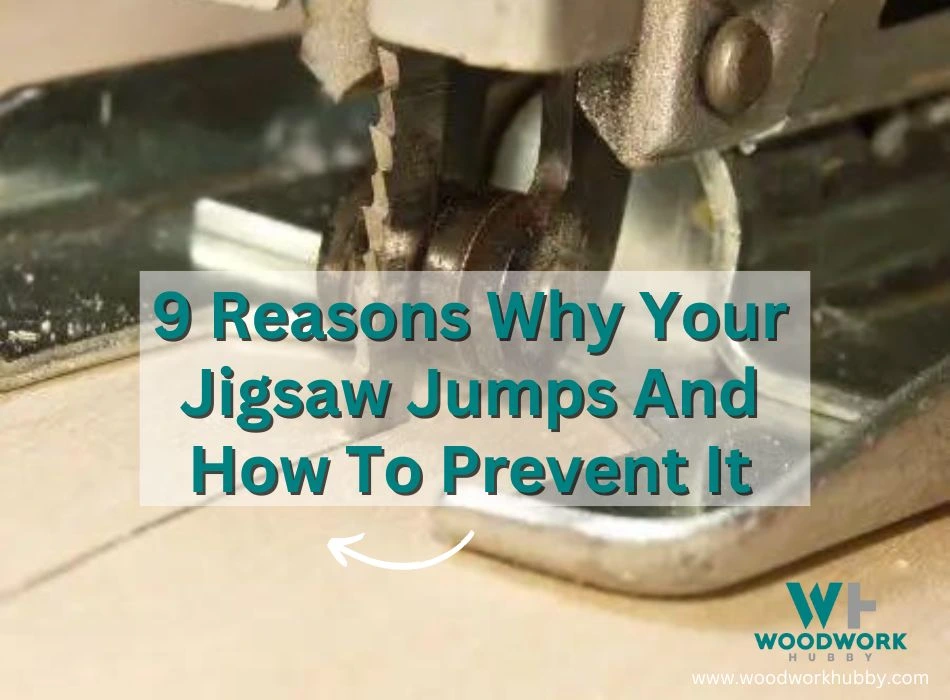The jigsaw is the most used tool in most people’s workshops. I certainly use mine often. But occasionally, I find that the base of my jigsaw jumps and marks my timber. I decided to do some research into why does my jigsaw jump and I gathered the following information to help you out.
Here are 9 reasons your jigsaw jumps:
- Wrong type of blade
- Blunt or Worn blade
- Cheap blade
- Bent blade
- Incorrect blade length
- Cutting too tight a curve
- Improperly installed accessories
- Loose accessories
- Bad bearings
As you can see, most problems do stem from the blade. Ahead, I’ll talk further about the above reasons, why your jigsaw jumps. I’ll also tell you about my favorite methods for preventing jigsaw bouncing and jumping, so make sure you keep reading! There’s lots of great information to come.
Why Does My Jigsaw Jump When Cutting?
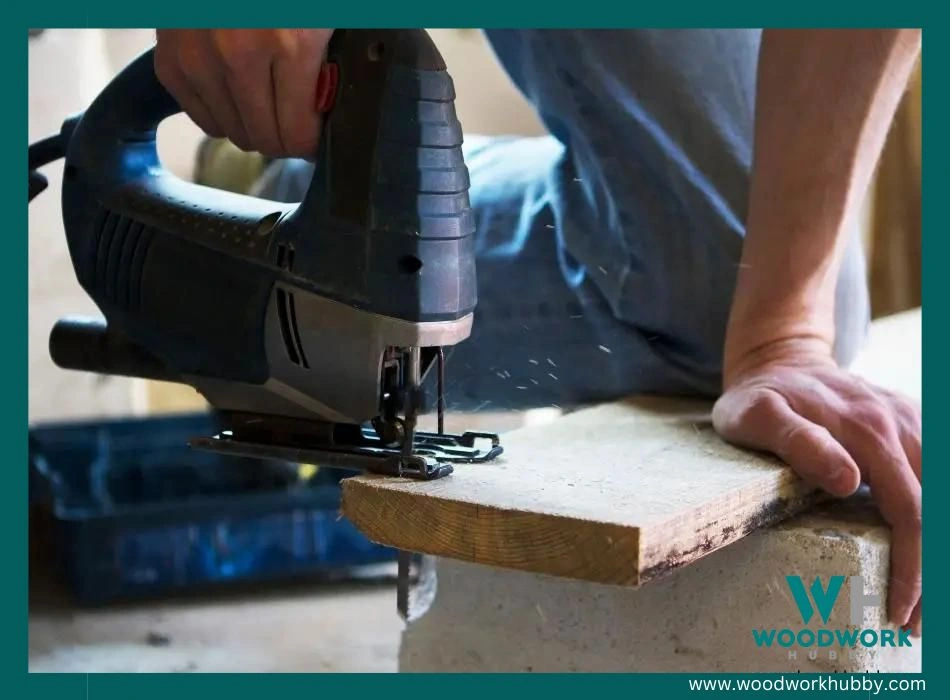
1. Wrong Type of Blade
Jigsaw blades come in a variety of different types. Almost too many to mention! If you are unaware of the type of blade you are using this can cause your jigsaw to jump and here is why.
Most jigsaw blades have teeth pointing upwards but sometimes if you want to cut some particleboard and not chip the surface, opting for a downward cut blade like the one pictured will give you the best results.
The problem with a jigsaw blade with downward-pointing teeth is those teeth sometimes grab in the wood fibers, and as the blade goes down, it will push your jigsaw up. This can cause your jigsaw to jump.
A jigsaw blade with downward-pointing teeth is the most common reason a jigsaw will jump!
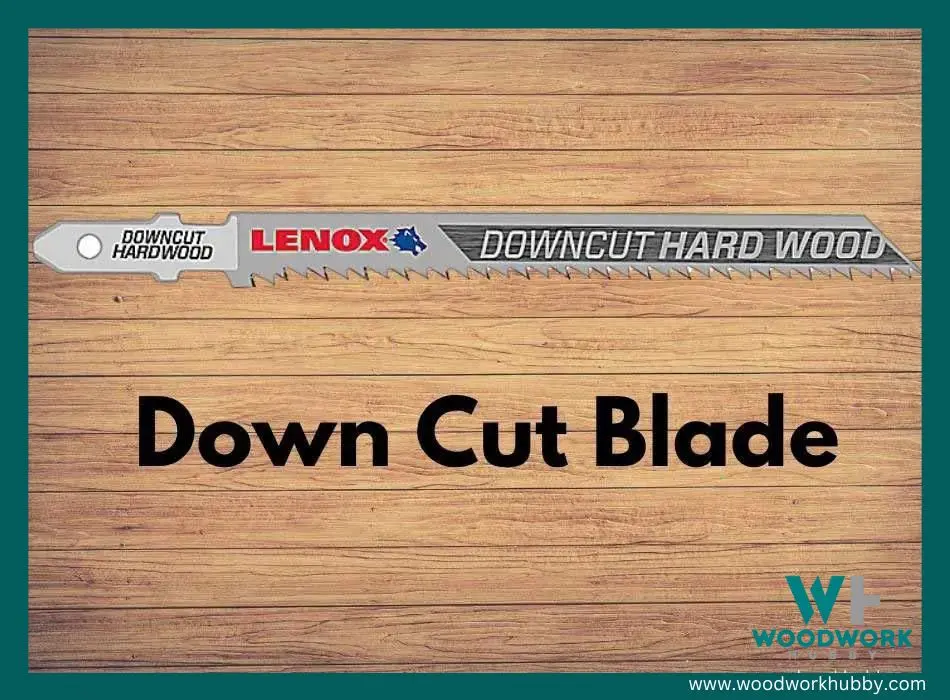
These types of jigsaw blades usually get worse over time as the blade starts to get blunt. You will notice your jigsaw wants to jump more and more. Time to swap it out for a new one!
These are the jigsaw blades I use and they are available at Amazon.
Freud DJT20S 20 pc T-Shank Jig Saw Blade Set
I’m not saying don’t use one of these blades, although keep in mind this can be an issue.
Does your jigsaw blade keep falling out? Read this article where I explain how to stop it from happening.
2. Blunt or Worn Blade
Even the highest-quality jigsaw blades don’t last forever. A blunt or worn blade will usually mean the blade’s “set” is worn down. “Set” refers to how much the teeth protrude out each side of the shank of the blade. The set provides clearance for your blade to cut through wood without binding.
Essentially, once the set is worn, meaning the teeth are quite blunt, your blade will tend to create friction inside the cut, causing it to push your jigsaw up and bounce.
This is why you may have noticed a well-used blade usually has some burn marks on the sides.
I always throw my blades out after the sides of the blade look worn. Jigsaw blades are not very expensive, so it is easier to grab a new one than put up with a bouncing jigsaw!
3. Cheap Blade
I’ve mentioned this a few times in previous articles, but please do not buy cheap blades! They are made from rubbish steel and will tend to bend easily and not hold a sharp edge.
Blades that bend, even only slightly, can cause the blade to grab in the cut and make your jigsaw jump.
If you use a good-quality blade, you will have a cleaner and safer cut, which will give you a better outcome for your project.
4. Bent Blade
Another reason your jigsaw may jump is that the blade is bent. See my full article on why does my jigsaw blade bend and how to stop it from happening now!
Sometimes your blade binds in the cut and as the jigsaw pushes the blade down, it will bend the blade. This bend can vary from small to excessive. A bent blade will most certainly cause your jigsaw to jump as the blade cannot travel up and down as intended.
I have found that some blades do not bend back easily, in fact, they may keep a slight bend to their shape. which is something to keep in mind. You’ll have no choice but to throw your jigsaw blade away and start over.
5. Incorrect Blade Length
This might seem strange to you, but some people do not consider the thickness of the wood they are cutting.
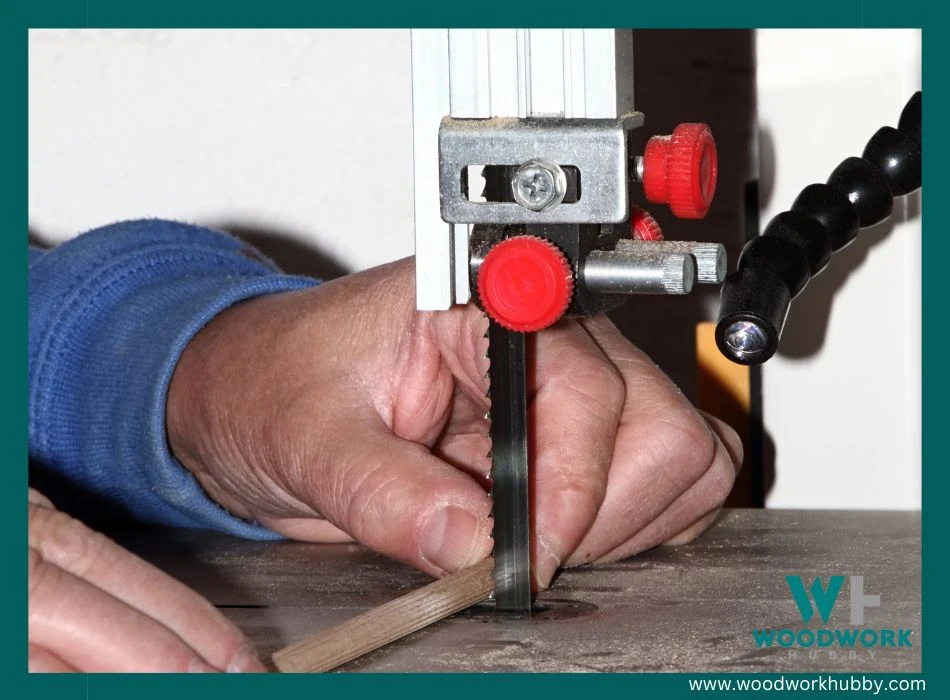
Just remember, when your blade moves up to its full starting height in the jigsaw, the end of the blade needs to be protruding out the bottom of the piece of wood you are cutting. This ensures that the end of the blade does not catch on the wood as it moves down again.
In my cabinetmaking days, we often cut sinks into countertops with short blades. They would sometimes catch on the wood and make the jigsaw jump. You will need the right blade to cut through a 2×4 with a jigsaw. Check out my article which explains if it is possible!
Be sure to check the blade length by unplugging the jigsaw from power and moving the blade up to its top position with some gloves.
6. Cutting Too Tight a Curve
A jigsaw is designed to cut not only straight but curved cuts. We all know that. If you are cutting a curve that is too tight for the blade, the blade can start to bind in the cut which can cause your jigsaw to jump.
The back of the blade will usually cause this binding and friction as it rubs on the kerf. If you intend to do some sharp curves, always use a thinner blade. The packet your blade comes in will usually tell you what diameter cut the blade can handle.
Ever tried to cut MDF with a jigsaw? Here are my foolproof ways of getting it right every time.
7. Improperly Installed Accessories
Do you use accessories with your jigsaw to make it more efficient? Do those accessories happen to be guides or something akin to those? I wouldn’t dissuade you from using accessories if they help you, but you have to take the time to install them properly.
Please, read the instructions front to back and then again or watch a YouTube tutorial to ensure you have everything assembled right. If you don’t, then your jigsaw will likely begin to jump once you use it.
At least the process of elimination here is rather easy. If you only installed a guide or another accessory a few days ago and your jigsaw is bouncing when it wasn’t earlier this week, then you know it’s the accessory that’s causing the problem.
You can remove it and reinstall the guide correctly and your bouncing issue should be a thing of the past.
8. Loose Accessories
Sometimes, your guides or other jigsaw accessories come loose. This can happen with time.
Your jigsaw is a power tool, and it will produce vibrations when it’s running. Vibrations, mind you, are not the same as bouncing or jumping. Even still, the vibrations can cause your guide or other jigsaw accessories to loosen.
If you didn’t install the accessories correctly in the first place, then they might be loose from the onset, so it doesn’t take much jigsaw use for the guide to loosen enough to cause jumping.
9. Bad Bearings
Your jigsaw has bearings, a type of element that limits motion so the saw moves only as intended. The other purpose of a bearing is to prevent friction between all the moving jigsaw parts.
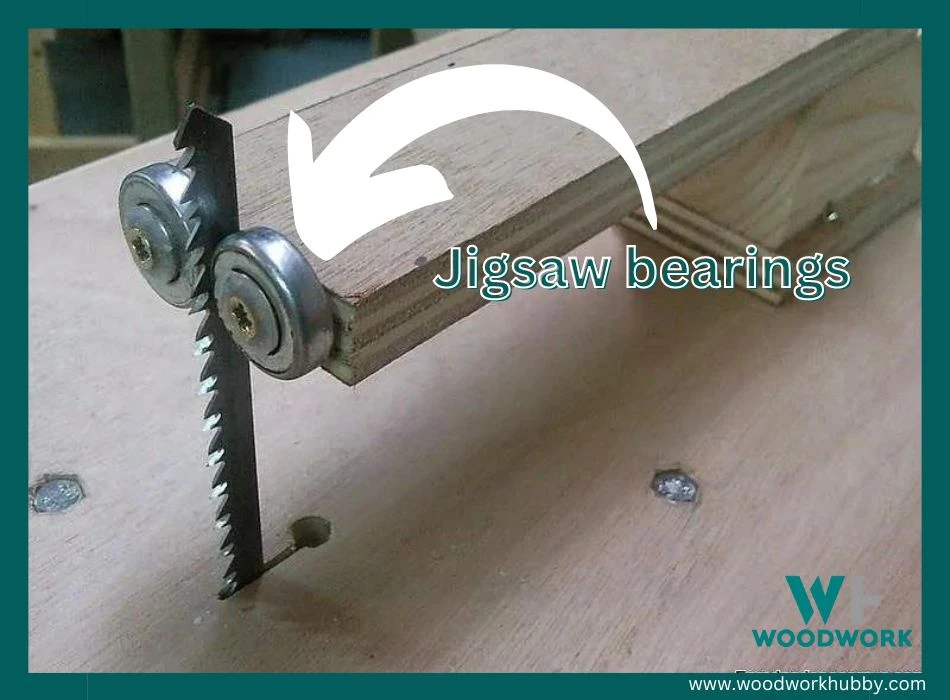
When bearings begin to go bad, you’ll typically hear a noise when operating your jigsaw that you didn’t before. The noise can sound like moaning, humming, or growling.
If you use a lot of power tools around your woodworking space or if you enjoy listening to music while you cut (without earbuds or headphones for safety’s sake, of course), you might not even hear the bearing noises.
That’s because the sounds are rather low, so they’re easily missed.
You should get into the habit of checking your jigsaw’s bearings every few months or more frequently if you use your woodworking tools often enough.
To access your jigsaw’s bearings, open the case and take out the brushes. Once you remove the armature as well, you can freely spin the bearings. That’s a great way to determine whether the bearings are worth keeping.
Bearings that don’t spin easily are too old to continue using with your jigsaw. By leaving the bearings in, the bouncing issue when operating the saw will only continue to worsen since the bearings will degrade more and more.
How to Prevent a Jigsaw from Bouncing
The last section was quite enlightening for you, as now you have a few ideas about why your jigsaw jumps. How do you control the jigsaw and stop the bouncing?
Here are some tips for lessening jigsaw bouncing:
- Use good quality blades
- Change your blades often
- Ensure you are using the right blade
- Make sure everything on your jigsaw is secure
Allow me to explain how and why these methods work!
Use Good Quality Blades
I mentioned this before, but I want to touch on it again now. A good jigsaw blade can save you so much heartache!
A quality blade is made from good steel and will have well-defined teeth on it. These blades perform better cuts and will generally outlast other blades.
Experience has proven to me that good blades make all the difference in almost any jigsaw! I suggest grabbing these jigsaw blades that I always use and I’m sure you will also be satisfied with the results.
Change Your Blades Often
Jigsaw blades are not expensive so make sure to keep a few spares on hand and swap them out after they start going black or the teeth look and feel dull.
A sharp blade will cut easily and not bind up in the kerf.
I often buy jigsaw blades in bulk as they are cheaper and you always have them on hand.
Use the Right Blade
There are so many jigsaw blades to choose from which all make different types of cuts for different materials. Be sure to take the time to check the specs on a blade before beginning the cut.
I often find that using a wide blade for curves is one of the biggest reasons that a jigsaw will bounce. The back of the blade binds in the back of the cut and gets caught up.
Secure Fittings on the Jigsaw
Loose accessories or fittings on your jigsaw can be a problem in that they vibrate and in some cases can cause your blade to wander off course. When this happens the blade can get caught and make your jigsaw jump.
Not only that but it’s untidy and dangerous to have loose fittings on tools.
How Do You Stop Jigsaw Kickback?
What if your jigsaw isn’t bouncing per se, but kicking back? Kickback in saws occurs when the teeth of your saw’s blade apply so much force that the saw begins moving erratically.
If this sounds terrifying, that’s because it is. The blade of your jigsaw can fly back towards you, typically slicing your fingers in the process. The injuries this can cause are catastrophic, as limb loss is a very real possibility.
How do you stop jigsaw kickback? The best way to prevent jigsaw kickback is to replace the blade before it becomes dull. A dull blade needs greater force to work than a sharp blade, and that force can contribute to dangerous kickback.
Be sure the jigsaw reaches speed before plunging into wood!
This is another testament to always replacing your jigsaw blades before they’re so dull you can’t see any teeth left.
How Do You Stop a Jigsaw Blade from Wandering?
So far, every time you’ve used your jigsaw, you’ve had no choice but to do so with a guide since your saw seems to run amok however it wishes. This wandering is annoying, as your woodworking project will be on track one minute and then completely ruined the next.
What’s happening here? Well, lots of things.
- You could be using a jigsaw for a job that it’s not well-suited for. You only need a jigsaw when cutting curves and shapes into the wood, not as much for straight lines.
- It could also be that you bought a cheap jigsaw. Cheap tools often don’t run straight and I have found this to be the case with jigsaws in particular. The blade holder in cheap machines does not hold the blade straight which means you constantly have to fight it to stay on the path.
- Inexpensive, thin blades can also increase a jigsaw’s rate of wandering. Once you have a thick, toothsome blade in the jigsaw, most wandering issues usually stop.
Conclusion – 9 Reasons Why Your Jigsaw Jumps And How To Prevent It
Jigsaw jumping can lead to serious injury, not to mention the woodworking project you were doing is completely destroyed. Now that you understand what causes your jigsaw to bounce as well as how to stop it, you can take control of your power tools and make them work with you, not against you!
I hope this article has helped you get back on track with your jigsaw.

